Dental Emergencies With Braces

Braces are incredible devices that can help transform your teeth and reshape your jaws. However, they are not always fool-proof. Every so often, a patient will have a dental emergency. That may be a bad cavity that needs to be fixed, or a bracket or wire will break. There are only a few dental emergencies that can happen with braces. We can help you to know what to do when each of those emergencies happen!
Origins of Braces
Orthodontic treatments have been around for a long time-even as far back as the ancient Egyptians! Although their ways were archaic, people for centuries have been trying to fix crooked teeth and develop a prettier smile through orthodontic work. The ancient Greeks, Romans, and Etruscans were known to have practiced orthodontia, and interestingly, the Etruscans used to attach gold bands to women’s teeth to preserve the position of their teeth after death. Orthodontics saw a surge in progress during the 18th century thanks to Pierre Fauchard. Known as the “Father of Dentistry,” he invented an appliance called a bandeau, which was a horseshoe-shaped piece of metal with regularly spaced holes that fit around the teeth to correct the alignment. He would also use forceps to physically realign teeth into their correct positions and tie them to neighboring teeth until they healed.
Orthodontics in the United States exploded during the 19th century. J.S. Gunnell created a type of headgear that fashioned to the head and exerted a soft pull on teeth while Charles Goodyear invented vulcanized rubber which would eventually become one of the most commonly used appliances in orthodontics. But Edward Hartley Angle, the “Father of Modern Orthodontics,” took orthodontics to another level by identifying the true properties of malocclusion, or misalignment, and addressed them with his own set of orthodontic appliances in 1880. Until the 1970s, orthodontist would attach anchored brackets around each tooth with winding wires, but with the invention of dental adhesives, orthodontists could then stick the brackets to teeth surfaces. Stainless steel then replaced gold and silver as the most popular option for wires, due to its manipulability, and became the most cost-efficient option for braces.
Dental Emergencies and What To Do About Them
Braces have come a long way since their beginnings many centuries ago, but as braces have evolved, so have the problems that come with them. Although dental emergencies are few and far between when it comes to braces, there are some common issues that can be readily addressed and fixed if serious enough. The least serious issues that you can have with your braces is tooth tenderness and lip and cheek sores. As your teeth become accustomed to your braces, your teeth will most likely be sore for 2-4 days. Using headgear, rubber bands, and springs can add to this soreness, but that discomfort normally goes away in the same amount of time. Eating soft foods and taking an over the counter pain reliever can help dull the ache. Loose or broke bands and brackets are also another annoyance that sometimes occur with braces. Although not considered an emergency, they normally break due to patient’s eating prohibited foods or picking at their braces. Whenever this occurs, place a piece of wax on the spot of irritation and wait until your next orthodontic appointment, unless the broken bracket breaks on one of the upper or lower front four teeth, then call your orthodontist as soon as possible.
Protruding wires are not only bothersome, but can stab the inside of your lips and mouth if not fixed. Wires can come loose from eating sticky foods, like candy, or by picking at your braces. If this has occurred, try using a Q-tip or pencil eraser to push the wire in towards the teeth. To avoid accidental damage to the wire, make sure to not bite your nails or pens and pencils. In rare occasions, a piece of the appliance may break and be swallowed by the patient. Although alarming, keep calm and have someone look in your mouth to see if the appliance if visible. If confident that you can remove it, you may carefully attempt to do so. If you are unable to see the piece, are coughing excessively, or having difficulty breathing, that could be a sign that the piece could have been aspirated and you should contact your orthodontist immediately.
How To Protect Your Braces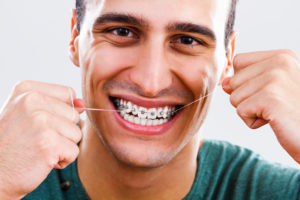
Unless under extenuating circumstances, most dental emergencies are avoidable. Maintaining good oral health and hygiene throughout your time with braces is vital in ensuring healthy teeth and gums, and preventing cavities. Food particles are easier to get stuck between braces, and when not cleaned thoroughly, can lead to other dental emergencies, like tooth decay, which can cause major complications. Hard foods, sticky foods, and foods high in sugar should be avoided as they are known to break brackets and cause cavities, which you more susceptible of developing while wearing braces. Some of the need-to-avoid foods include hard candy, nuts, apples, popcorn, ice, gum, caramel, and licorice.
Because braces are so notorious for getting food stuck in them, make sure that you are brushing after every meal to prevent staining and reducing bacteria buildup in your mouth. Use a soft brush, and brush each tooth by starting at the top and brushing down, then repeating the motion and brushing up around each bracket. Use threadable floss of a floss threader to get the hard to reach areas in between teeth that are covered by the archwire. Using the pointed end, insert between the teeth and gently move the floss back and forth between the two teeth. For added care, use a proxabrush, sometimes called a “Christmas tree brush,” to scrub between each bracket in an up and down motion to get any extra gunk that might be stuck there. For any dental emergencies that you might be having, make sure to contact Belmar Orthodontics at (303) 225-9016 for your next consultation!
Choosing A Good Toothbrush
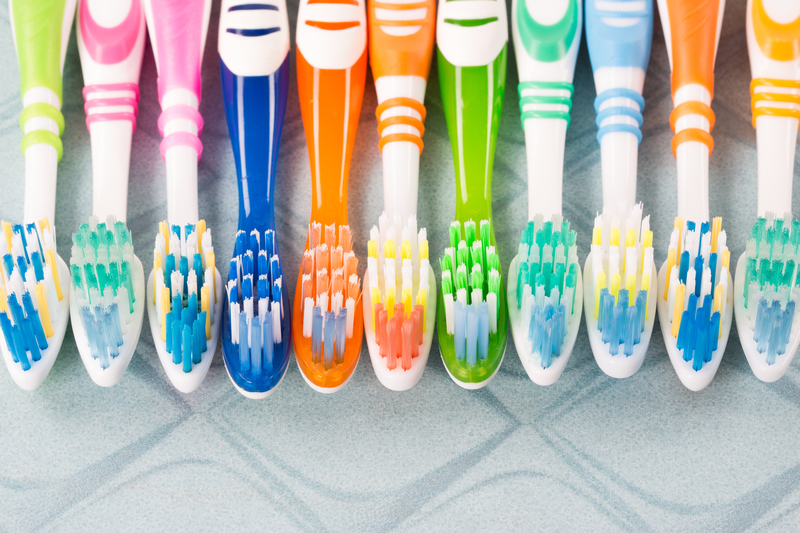
Do you ever look at all the toothbrush options at the store and wonder what the difference is between all of them? Toothbrushes come in all shapes and sizes, and it’s for a reason. They are made to fit certain sizes of mouth. Bristles come in various materials and designs, and there are extra features on some toothbrushes. So what should you choose? Use these tips for the next time you pick out your toothbrush so you know you’re getting a good one for your mouth!
Why So Many Different Kinds?
For something that is so simple to use, there sure are a lot of different toothbrushes out there. Toothbrushes have been around for centuries, with some historians quoting them as being as old as 3000 BC! Ancient civilizations used a “chew stick,” or a twig that had a frayed end in which they would brush their teeth. The common bristled toothbrushes that we are so familiar with didn’t come into existence until around 1498 in China. The bristles that were used in these toothbrushes were actually hog hair that were attached to handles made of bamboo or bone. Even these evolved, though, into the toothbrushes that we use today, but instead with nylon bristles and plastic handles.
Since World War II, oral health has increased in popularity and a variety of different toothbrushes have been invented. But which ones are best? How do you know which toothbrush is for you? Toothbrushes are specifically designed for different sizes and shapes of mouths, plus there are age-specific toothbrushes, like for children, that have smaller (or larger) handles and bristles depending on the age of the person. No matter what toothbrush you use, the principle behind it should be the same: improve your oral health care and prevent disease. Your toothbrush should be helping you do that, if you’re using the right one.
Types of Toothbrushes
There are basically two types of toothbrushes: soft-bristled and hard-bristled. Most dental professionals agree that using a soft-bristled toothbrush is best for cleaning plaque and debris on your teeth. Hard-bristled toothbrushes are not recommended as they are known to wear away your enamel and can lead to gum recession and lesions. Although they do remove more plaque than traditional soft-bristled toothbrushes, hard-bristles cause more damage than good, even when trying to get rid of tough plaque. Toothbrushes with small heads are also great to use because they can get into the hard-to-reach places in your mouth. When deciding between a small-headed or large-headed toothbrush, keep in mind that the size of your mouth should be the determinant for which one you buy. Those people with large mouths should use a full-sized toothbrush head, while those with smaller mouths should utilize a more compact head.
Toothbrushes also vary in the type of the handle (non-slip grip or flexible neck), shape of the head (tapered or rectangular), and style of bristles (rippled, flat, or dome shape). Although there are a variety of kinds, ultimately the best toothbrush is one that fits your mouth and allows you to reach all of your teeth easily. To figure out which one works best for you, trying toothbrushes with different bristle styles or head shapes is recommended until you find one that is most comfortable.
Manual or Electric: Which is Better?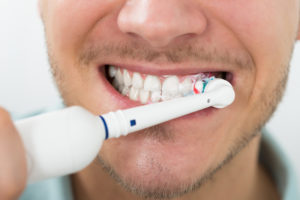
With the advent of the electric toothbrush, many people have been drawn to its ease of use and effectiveness. While manual toothbrushes have been used for centuries, the electric toothbrush is faster and more efficient. If you’re a diligent brusher, manual toothbrushes are a great option, but for those who want the toothbrush to do the work for them, electric is the way to go. Just like manual toothbrushes, electric toothbrushes come in different sizes and have a variety of replaceable heads. Electric toothbrushes are known for having smaller heads than manual, so at the beginning, it may take some time getting used to their small size.
Because of their size, electric toothbrushes are able to clean teeth more thoroughly and get to hard-to-reach areas of the mouth better than manual toothbrushes can. Electric toothbrushes also use different types of bristles movements, such as oscillating/rotating technology, that has been proven to remove more bacteria and plaque than manual toothbrushes. Additionally, electric toothbrushes have a smaller likelihood of hurting your enamel and gums, which is advantageous for those individuals who have sensitive teeth and gums. Whether you choose manual or electric, the most important takeaway is that both fit your mouth size and allow you to clean each individual tooth. If your toothbrush can do both of those things, you’re on your way to achieving great oral health and a nicer smile.
Tips For A Cleaner Mouth
Having the correct toothbrush for your mouth is the first step in maintaining good oral health. But a common question that many have is, “What is the correct way to brush my teeth?” When using a regular soft brush, make sure to angle the brush along the gum line and brush down from the top, then up from the bottom on each tooth in small circles. This motion helps get out the tiny food particles stuck between your teeth, plus it protects your gums from over-brushing. If your gums tend to bleed when brushing, that usually indicates that the gums are inflamed and those areas should actually be brushed more thoroughly and more often. Also make sure that you are brushing your chewing surfaces, the inside of your teeth, and your tongue.
For more tips on how to protect your teeth and maintain a healthier mouth, visit your local provider at Belmar Orthodontics. Change your oral health for the better by calling (303) 225-9016 and setting up your first consult for the comfort, care, and personalized treatment that you deserve!
Braces With Oral Health Problems
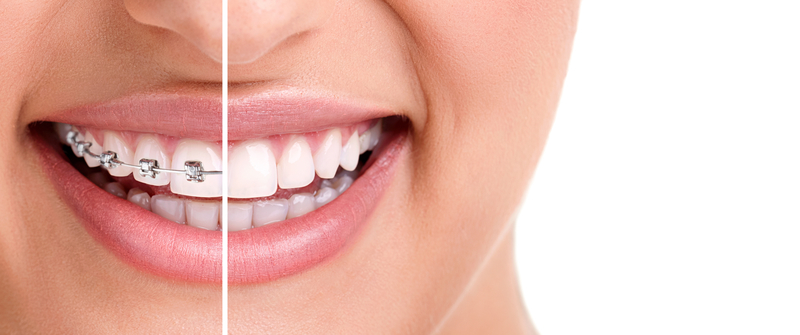
Did you know that your oral health can affect your overall health? Poor oral health can even worsen health conditions you already have such as diabetes or cardiovascular disease. That is because oral health and overall health are highly connected. Your oral issues can become better with braces, but that is only if certain oral health problems are corrected beforehand. Patients can also develop oral health problems if they don’t have the right knowledge with proper braces care. Use these tips to avoid oral health problems with braces and find out how we work around current problems to provide you with a straighter smile!
Oral Health Goals
Did you know that orthodontic treatment can give you a healthier mouth? We know that braces help straighten your teeth, but they can also improve the health of your gums and teeth. When you have crooked and crowded teeth, this makes cleaning your mouth more difficult. This can cause serious oral health problems, such as tooth decay, periodontal disease, and tooth loss. Whether you have straight or crooked teeth, before you let an orthodontist start working on you, there are some important oral health tips to be following before any work begins:
- Eat a healthy diet that limits sugary beverages and snacks
- See a dentist regularly for prevention and treatment of oral disease
- Brush teeth twice a day with fluoride toothpaste
- Floss daily
- Discuss changing certain lifestyle practices, like smoking and using oral piercings
Types of Braces
Braces are a big commitment, and you want to make sure you’re using the correct ones whenever you get them put on. Each of us is a different size and shape, and are mouths aren’t any different. Because of this, there are various types of braces for different sizes and shapes of mouths for children, teenagers, and adults. The four most common types of braces are: traditional, short-term, clear, and Invisalign/ClearCorrect.
Traditional braces are those that we see on a daily basis: a system of wires and brackets that are bonded to our teeth. This type of braces are the most cost-effective, reliable, and are best suited for severe orthodontic issues. Short-term braces are recommended for those patients who wish to align just their front six teeth-the ones that others see the most. These are used for the shortest amount of time (less teeth to align), but there is no adjustment to your occlusion (bite). So if you have a problem with an under/overbite, short-term braces may not be for you. Clear braces are similar to traditional metal brackets except that they use ceramic brackets that match the color of your teeth. These braces have a high aesthetic appeal for those who don’t want to be seen wearing braces, plus they are highly resistant to staining. Invisalign//ClearCorrect straighten your teeth without the traditional wire brackets, and are completely removable, which makes cleaning your teeth a cinch. This type requires more responsibility for the wearer, but if you’re committed to the strict wearing regimen, you can have a straight smile in as little as 12 months!
Taking Care of Your Braces
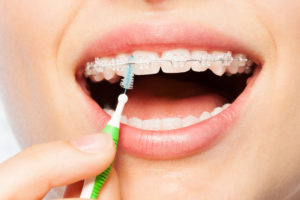
While similar to managing our oral health, maintaining our braces has a few extra steps. To maintain good oral health with braces, it’s important to adopt good oral hygiene throughout the entire process. Brushing after every meal is one of the most important but most overlooked steps in maintaining good oral health. When eating, food particles get stuck in between our teeth and our braces, which can cause staining and bacterial backup between our teeth. Using a regular soft brush in an up-and-down motion on each tooth will do the trick. Secondly, use threadable floss or a floss threader. These tools allow you to get between each tooth and underneath the wires to clean out any food that may be trapped there. Insert the threader between two teeth and move back and forth until the food is released. Lastly, use a proxabrush, or a “Christmas tree brush.” Place the proxabrush between two brackets, below the archwire, and brush up and down. Like the threader, this will also help loosen up any food that may be stuck between your teeth.
A great way to ensure that your braces don’t break and that you don’t get unwanted gunk stuck in them is to watch what foods you’re eating. Foods that are hard, sticky, or high in sugar should be avoided. Eating food that is high in sugar can cause cavities when wearing braces, which can lead to more dental work that you would need to have done. Furthermore, patients with braces should limit between meal snacks and avoid food that could bend the wires, such as caramel, nuts, chewing gum, ice, or popcorn.
When To See An Orthodontist
Now that we understand more about the importance of our oral health, plus the different types of braces, when should we make an appointment with an orthodontist? Many times, we only schedule a time to see an orthodontist whenever our teeth are crooked and we want them straightened. But there are other factors that influence when we should start thinking about getting in to see the doctor:
- Jaws that shift, make sounds, protrude, or are recessed
- Speech difficulty
- Biting the cheek or biting into the roof of the mouth
- Facial imbalance or asymmetry (features out of proportion to the rest of the face)
- Inability to comfortably close lips
- Grinding or clenching of teeth
As mentioned earlier, these are signs that your oral health might not be up to par like it should be. Meeting with your orthodontist and discussing these issues will help them better treat you with one of the four types of braces that we discussed previously. The sooner you get in to see your orthodontist, the sooner any pain or discomfort can be evaluated, treated, and extinguished.
Meet Your New Year’s Resolutions With Our Help!
Belmar Orthodontics can help you on your path towards having a straighter smiles and better oral health. With reputable orthodontists, manageable treatment plans, and services for children and adults, we can help you get the smile that you deserve! Call (303) 225-9016!
Dressing Up Your Smile During the Holidays

The holidays are here, which means parties, dinners, photo opportunities and more. Now is a great time to make your smile shine, and you can do that through orthodontic treatment. If you’re smile is lack-luster, consider our four orthodontic options that can help you have a straighter smile. For those already with braces, you can dress up your brackets with bright colors to reflect the season. Use these tips for getting a more beautiful smile with braces and having that show in your holiday snapshots this year!
Dress Up Your Smile with Orthodontics
The higher number of holidays during the winter season is believed to be because of the many pagan festivals that surrounded the Winter Solstice many years ago. That solstice happens in the third week of december, where there is Christmas, Hanukkah, New Years and other holidays all happening. With all those holidays and the gatherings that come with them, it’s likely to mean many opportunities for photos and showing off your smile. You want that smile to impress.
Studies show that people that straighten their smiles often feel more confident than those who don’t. That confidence can be visible even while you are currently getting orthodontic treatment. Straight teeth are so important to people that 87% of people are willing to forego something they want for a year or more to be able to get braces. If you have braces, not only is it something to be proud of, but something to be admired. If you don’t have braces, getting them is a great way to give yourself an amazing gift just in time for the holidays.

Your Treatment Options
In the past, metal braces were your only option. However, you have many cool options today that you can gift yourself such as:
- Traditional Metal Braces – These are the classic metal bracket and wire option that is most commonly chosen by patients. Patients who chose this option come in to have their wires tightened at each appointment.
- Ceramic Braces – These braces are a close cousin to metal braces. They have the same bracket and wire design of metal braces, except that they are made out of ceramic material. This helps decrease demineralization during your orthodontic treatment. Ceramic material is also naturally white, helping these braces to blend in with your teeth more than metal would.
- Lingual Braces – These are metal braces that are placed on the back of your teeth. Instead of just a square bracket, the metal must be custom-made to the shape of the back of your teeth. This is a discrete option that adults and teens love.
- Invisalign Treatment – This is the most invisible option available to our patients. Invisalign is a series of transparent aligners that you wear at night and throughout the day. You can remove them for eating, playing sports, cleaning your teeth and more.
If You Already Have Braces
Maybe you already have braces. You can still make your smile wow in pictures by taking care of your smile. If you have metal or ceramic braces, our patients love to get colored bands that reflect the colors of the holidays. You can make your bands green and red for Christmas, blue and white for winter or any color you would like. Colorful bracket bands are just one way you can dress up your smile.
If you already have braces, then you have already started on your journey to a better smile. Orthodontic treatment can correct mild to severe issues with bite and alignment, and can help correct speech impediments. It can bring the teeth and jaws into proper position, reducing your risk for oral health diseases such as tooth decay and gum disease. Straighter teeth are teeth that are easier to clean and less likely to have breaks and fractures from uneven mouth pressure.
However, if you want your smile to dazzle in photos and at holiday get-togethers, you have to take care of it. The best way to do that is by brushing and flossing your teeth. Those two simple steps should be dones several times a day to keep your brackets clean and your teeth polished. Patients should brush 3 times a day or more to dislodge food and to clean the teeth after meals. Flossing should be done 1-2 times a day. Even though it takes a bit longer to do, don’t skip this step! If you do, you miss cleaning 40% of your tooth surfaces that can leave them open to decay, erosion and staining. Those are not things you want in a holiday photo.

Better Health for the New Year
The end of the year is a time to start making goals for the new year. One of those goals can be focused around having better health in the new year. Many people don’t realize just how connected oral health is with overall health. Countless chronic conditions can become more mild or they can intensify depending on how well you are taking care of your oral health. For example, if you have diabetes, not taking care of your teeth and gums can lead to oral infections that are really hard to battle because you have diabetes. Your body is less able to fight those infections and the infections can spread, worsening your condition.
However, if you do the basics of brushing your teeth, flossing and visiting your dentist and orthodontist like you should, you can keep your oral health in great shape. That makes it so your smile is amazing when your braces come off instead of damaged or decayed. To get some tips for taking care of your braces or for starting on an orthodontic plan, call Belmar Orthodontics today at (303) 225-9016!
The Importance of a Beautiful Smile

At Belmar Orthodontics, our success is depends on your success. Part of achieving that success is having a beautiful smile. Studies show that a straighter, more beautiful smile can help you to become more successful and be perceived as such by others. A more beautiful smile can help your self-esteem, your social standing, and can open opportunities to you that you otherwise would not have had. However, a great smile is something that takes dedication and special care throughout your life. We can help you know how to care for your smile to keep it dazzling. We can also provide you state-of-the-art treatment and services that can provide you a beautiful smile as well as patient education for keeping that smile healthy for life. Learn more about how a more beautiful smile can benefit you and how you can achieve it!
Healthy Smiles Take Work
To have a beautiful smile, you have to take special care of your teeth. You do this through proper oral health hygiene practices, which includes brushing and flossing your teeth every single day. The American Dental Association recommends brushing your teeth at least twice a day and flossing at least once a day. Notice how we said “at least”. This means that you can brush and floss your teeth even more than those recommended amount of times each day. In fact, brushing and flossing after every meal can significantly reduce your risk for tooth decay and gum disease. We also said you must practice this routine “every day”. This is the part that takes work.
To keep your body healthy, you must have solid, healthy habits that take up a part of your every day. To keep a healthy body you must take time to eat right and to exercise. In order to have healthy eyes, you need to visit your eye doctor. To keep your teeth healthy, you have to take time to clean them as well as visit your dentist. How often? We recommend going to the dentist at least twice a year, if not more. For your orthodontic work, you will come into the office every 4-6 weeks. These appointments are very important to determine if your bite and alignment is healthy and in correct position. It is also very important to ensure you don’t have tooth decay forming, as braces are more prone to causing cavities because the teeth are harder to clean with brackets. A healthy smile takes work, but it is well worth the benefits your reap.
The Importance of a Beautiful Smile
Not only are healthy smiles great for you, but they are also more beautiful not only for you, but for others. A beautiful smile can impact the level of self-esteem you have as well as confidence. In fact, studies show that those who have a straighter, more beautiful smile tend to be more confident. They also are perceived as more confident and successful by their peers. For example, Invisalign conducted a study about the importance of straightening teeth and what it did for those who did it.
For adults, a straighter smile made them appear more successful to others. In many cases, it also helped them be more confident so that they actually were more successful. Between studying people with straight smiles versus those with crooked smiles, the ones with straight smiles were perceived as smarter and in 75% of cases, more trustworthy. People also perceived them as having more dates and as more attractive. Those with a straighter, more beautiful smile were also more likely to get a job (almost twice as likely as someone with a crooked smile). Studies conclude that a more beautiful smile works wonders for you in every aspect of your life!
How About Children?
Having straighter teeth and a beautiful smile is not only important for adults, but it makes an impact on a child’s life as well. In studies, children that had better smiles had a boost of confidence that helped them be more confident in their studies and with others. Teenagers also have this boost of confidence. In modern times, child orthodontics is becoming much more popular. Child orthodontics seeks to correct orthodontic issues present in childhood that would become much more severe later on in life.
We recommend that children see the orthodontist between ages 7 and 8. This is a time when bite and alignment issues manifest and when they can most easily be corrected. A child’s jaw is still forming and many of the baby teeth are falling out to make room for the adult teeth. With child orthodontics, we can correct bite and alignment so it is even. We can also monitor how the permanent teeth are coming into the mouth. This time period is one where many pre-teens have their teeth grow in. We need to make sure those teeth come in straight so that those teens can enjoy a beautiful smile that is straight, and that it is one they can carry with them throughout adulthood.
Get a Better Smile Today
Orthodontics can work wonders for the confidence, self-esteem and oral health of children, teens and adults alike. Some patients will only need treatment for a short time while others will need straightening treatment for 18-24 months. This investment is well worth your time for what a beautiful smile does for you personally and socially. If you would like to learn more about your orthodontic options and schedule your consultation today, call Belmar Orthodontics at (303) 225-9016!
Dentistry and Orthodontics Are Closely Related

Dentistry and orthodontics are quite different, but they are also closely related. You need care from both a dentist and an orthodontist in order to keep your smile healthy. Dentistry and orthodontics both deal with the health of your smile. One focuses on straightening the smile and other focuses on tooth decay, gum disease and treatments to help correct oral issues. Both involve services that “fix” problems with the teeth to help make your mouth healthier, thus making you healthier. Find out the difference between dentistry and orthodontics, the similarities, and how both can help you have the best smile possible.
What Dentists Do
Dentists go to school to specialize in problems involving the teeth, nerves, gums and jaw. They can provide any or all of the following services:
- Comprehensive exams and dental cleanings
- Oral cancer screenings
- Sedation dentistry
- Laser cavity detection and cavity detection using x-ray imaging
- Tooth extractions
- Laser tissue treatment
- Oral hygiene training
- Dental sealants
- Periodontal treatments on the gums
- Scaling and root planing for gum disease
Dentists are also trained in cosmetic dentistry and can provide services such as dental implants, porcelain veneers, porcelain crowns, cosmetic bonding, dental bridges and even botox treatment. Restorative dentistry involves root canals and root canal therapy, teeth-whitening services, tooth-colored fillings, and in some cases orthodontic care through Invisalign. The dentist is usually trained in orthodontics to provide this service. If a dentist finds that a patient has a problem with their bite or alignment, they will refer the patient to an orthodontist who is certified and trained to correct the issue.
What Orthodontists Do
Orthodontists must obtain several degrees to become orthodontists. They need more training than dentists do because they must be able to correct smiles as well as identify oral health issues. Orthodontists are specially trained with correcting bites, occlusion (or alignment), and in straightening the teeth. In a healthy mouth, the upper jaw rests on top of the lower jaw. The upper front teeth will rest slightly forward on top of the lower front teeth. Not all mouths are aligned correctly. Some bites that orthodontists correct include:
- Overbite – In the upper jaw, the front teeth rest over the lower front teeth instead of above. You never want the front teeth to overlap the bottom teeth completely, as this creates pain and other problems when biting, eating, and other everyday tasks.
- Underbite – This is the opposite of overbite. The lower front teeth rest far in front of the upper front teeth. This creates similar jaw problems as mentioned with overbite. Underbite can lead to jaw and joint pain, earaches, headaches. and more.
- Crossbite – Crossbite involves teeth that cross in all different directions. Some of the teeth are slanted toward the tongue. Other teeth are slanted towards the cheeks. This creates uneven pressure all over the mouth when biting and chewing, which can lead to broken or fractured teeth, weakened enamel, pain, and more. Crossbite can even cause abnormal facial development and jaw problems if left untreated.
- Openbite – Openbite refers to an opening (or gap) in the teeth between the upper and lower jaws when the mouth is closed. This gap is right at the front of the teeth and might even appear as a hole in a patient’s smile. Openbite leads to speech impediments, lisps and other problems with speaking if left untreated.
Dentistry and Orthodontics Compared
Did you know that an orthodontist has dental training? Orthodontists must obtain several degrees in order to work. They must obtain a Doctor of Dental Surgery (DDS) degree or a Doctor of Medical Dentistry (DMD) degree just as dentists do. Then, they must apply to an orthodontic graduate program to obtain a Masters of Science degree. Orthodontists go through all the same training as dentists and then some. This is how orthodontists can spot dental issues forming. Basically, all orthodontists are dentists but not all dentists are orthodontists.
If you have problems with your teeth, gums, oral nerves or jaw, then go see your dentist. Your dentist will refer you to an orthodontist if the issue is corrected by an orthodontist or has to do with bite, alignment or straightening. When it comes to problems such as tooth decay (cavities), both dentists and orthodontists can help you in some way. Orthodontic care via braces can help straighten the teeth, thus making them easier to clean and reducing your risk for tooth decay. Dentists can also help you prevent tooth decay with comprehensive exams, biannual cleanings and treatments that stop the progression of cavities if they have formed.
Benefit From Both
Both dentistry and orthodontics involve services that “fix” problems with the teeth to help make your mouth healthier, thus making you healthier. Both professions involve doctors who are highly trained to help problems with your oral health. Patients can benefit greatly from having both a dentist and an orthodontist. Take a step towards a healthier mouth, and schedule an appointment with Dr. Hardy today by calling Belmar Orthodontics at (303) 225-9016!
How Braces Improve Dental Health
Did you know that braces can improve your dental health? Dental and orthodontic care go hand-in-hand. Many dentists have training to spot problems with bite and alignment. These problems can be corrected with proper orthodontic care, and should be corrected early-on before children have grown. Receiving braces as a child can correct problems that become severe later in life. Receiving braces as an adolescent and even as an adult can greatly improve your oral health, as it decreases your chances for tooth decay and even gum disease. Straighter teeth are teeth that are easier to clean and easier to take care of. Learn how investing in braces can improve your dental health today!
Braces Improve Dental Health
DId you know that orthodontists also attend dental school? Orthodontists go through 4 years of undergraduate school, then move on to 4 years of dental school. Afterwards, they must complete and additional 2-3 years of special training to perform orthodontics. Orthodontists are skilled at not only making your teeth straighter, but also helping you to improve your dental health. Dr. Hardy understands how the teeth work and that straighter teeth are teeth that have a reduced risk for cavities and problems with gum disease.
When the teeth are crooked, it can make it much harder to clean between each tooth thoroughly each day. To keep a healthy mouth, every single day counts and plaque must be removed with frequent brushing and flossing. What if the crookedness of the teeth prevent your toothbrush or floss from reaching certain areas? Those areas will be prone to, and will probably start to develop, tooth decay and/or problems with the gums. In contrast, when the teeth have been properly aligned with orthodontic care, cleaning them becomes a simple task. A toothbrush can easily reach all the surfaces and floss can get in between each tooth. That gives you a much better chance at having great oral health.
What Else Can Braces Do?
Braces are highly beneficial for not only straightening your pearly whites, but also for correcting bite and alignment problems that so many children have. Between the ages of 7 and 8, a child should see an orthodontist and get their bite assessed. We look to see if your bite and teeth line up correctly. If they don’t, you may have one of the following: openbite, crossbite, overbite, underbite, malocclusion, etc. All of these problems can make chewing, speaking, biting, etc., difficult. If a smile is left untreated, problems that were minor become severe over time and require more extensive procedures. However, braces are a perfect method for fixing these problems at an early age, saving you time, money and your health.
Common Oral Health Problems
We mentioned that braces can help your dental health by lowering your risk for oral health issues. The two most common oral health problems are tooth decay and gum disease. You may know tooth decay by one of its other names: dental caries or cavities. Tooth decay is the erosion of the tooth enamel over time. Almost every patient has had some form of tooth decay in their life. However, tooth decay–or cavities–are 100% preventable if you have a habit of taking care of your teeth.
Tooth decay is caused by plaque—a sticky film made from sugars in the foods you eat mixed with bacteria. This plaque sits on the teeth and erodes the tooth enamel. Over time, that plaque can eventually weaken a tooth and get inside, where it will start to cause decay. The teeth aren’t the only ones that are affected by plaque. Plaque also attacks the gums, causing them to become swollen, red, and irritated. You may even see your gums bleed easier. When the gums continue to become inflamed, they will eventually recede from the teeth, causing the teeth to fall out. Thankfully, both tooth decay and gum disease are avoidable. Straighter teeth can help make brushing easier, and thus help decrease your chances for either condition.
Your Dental Health
When it comes to the teeth, you only have one set. You want to do all you can to keep your dental health intact. Straightening your teeth with braces can help you, plus, you’ll receive all the benefits a better smile can give you. So what are you waiting for? Schedule your appointment with Belmar Orthodontics today at (303) 225-9016!


